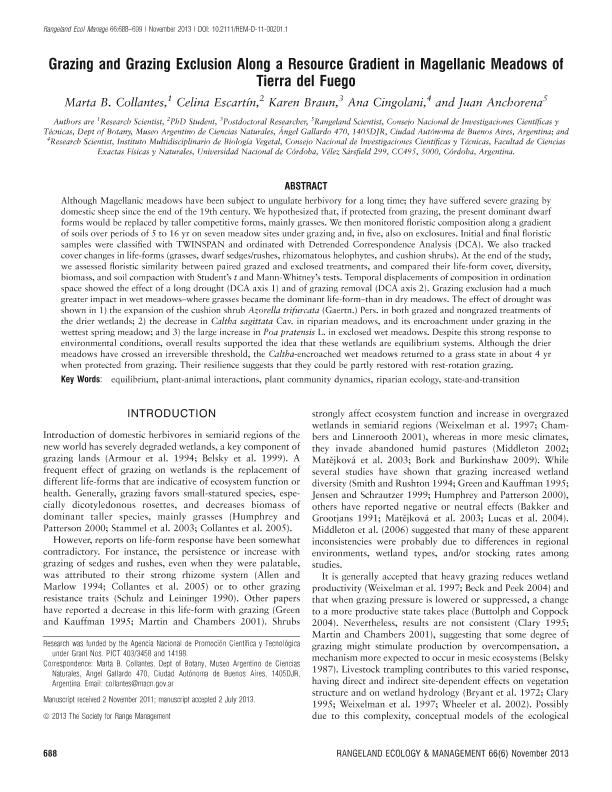Mostrar el registro sencillo del ítem
dc.contributor.author
Collantes, Marta Beatriz

dc.contributor.author
Escartin, Celina Andrea

dc.contributor.author
Braun, Karen
dc.contributor.author
Cingolani, Ana María

dc.contributor.author
Anchorena, Juan
dc.date.available
2017-01-03T17:27:04Z
dc.date.issued
2013-09
dc.identifier.citation
Collantes, Marta Beatriz; Escartin, Celina Andrea; Braun, Karen; Cingolani, Ana María; Anchorena, Juan; Grazing and Grazing Exclusion Along a Resource Gradient in Magellanic Meadows of Tierra del Fuego; Society For Range Management; Rangeland Ecology And Management; 66; 6; 9-2013; 688-699
dc.identifier.issn
1550-7424
dc.identifier.uri
http://hdl.handle.net/11336/10753
dc.description.abstract
Although Magellanic meadows have been subject to ungulate herbivory for a long time; they have suffered severe grazing by domestic sheep since the end of the 19th century. We hypothesized that, if protected from grazing, the present dominant dwarf forms would be replaced by taller competitive forms, mainly grasses. We then monitored floristic composition along a gradient of soils over periods of 5 to 16 on seven meadow sites under grazing and, in five, also on exclosures. Initial and final floristic samples were classified with TWINSPAN and ordinated with Detrended Correspondence Analysis (DCA). We also tracked cover changes in life-forms (grasses, dwarf sedges/rushes, rhizomatous helophytes, and cushion shrubs). At the end of the study, we assessed floristic similarity between paired grazed and exclosed treatments, and compared their life-form cover, diversity, biomass, and soil compaction with Student's t and Mann-Whitney's tests. Temporal displacements of composition in ordination space showed the effect of a long drought (DCA axis 1) and of grazing removal (DCA axis 2). Grazing exclusion had a much greater impact in wet meadows–where grasses became the dominant life-form–than in dry meadows. The effect of drought was shown in 1) the expansion of the cushion shrub Azorella trifurcata (Gaertn.) Pers. in both grazed and nongrazed treatments of the drier wetlands; 2) the decrease in Caltha sagittata Cav. in riparian meadows, and its encroachment under grazing in the wettest spring meadow; and 3) the large increase in Poa pratensis L. in exclosed wet meadows. Despite this strong response to environmental conditions, overall results supported the idea that these wetlands are equilibrium systems. Although the drier meadows have crossed an irreversible threshold, the Caltha-encroached wet meadows returned to a grass state in about 4 when protected from grazing. Their resilience suggests that they could be partly restored with rest-rotation grazing.
dc.format
application/pdf
dc.language.iso
eng
dc.publisher
Society For Range Management

dc.rights
info:eu-repo/semantics/openAccess
dc.rights.uri
https://creativecommons.org/licenses/by-nc-nd/2.5/ar/
dc.subject
Equilibium
dc.subject
Plant Animal Interactions
dc.subject
Plant Community Dynamics
dc.subject
Riparian Ecology
dc.subject
State And Transition
dc.subject.classification
Ecología

dc.subject.classification
Ciencias Biológicas

dc.subject.classification
CIENCIAS NATURALES Y EXACTAS

dc.title
Grazing and Grazing Exclusion Along a Resource Gradient in Magellanic Meadows of Tierra del Fuego
dc.type
info:eu-repo/semantics/article
dc.type
info:ar-repo/semantics/artículo
dc.type
info:eu-repo/semantics/publishedVersion
dc.date.updated
2016-12-12T14:17:18Z
dc.journal.volume
66
dc.journal.number
6
dc.journal.pagination
688-699
dc.journal.pais
Estados Unidos

dc.journal.ciudad
Boulder
dc.description.fil
Fil: Collantes, Marta Beatriz. Consejo Nacional de Investigaciones Científicas y Técnicas. Oficina de Coordinación Administrativa Parque Centenario. Museo Argentino de Ciencias Naturales; Argentina
dc.description.fil
Fil: Escartin, Celina Andrea. Consejo Nacional de Investigaciones Científicas y Técnicas. Oficina de Coordinación Administrativa Parque Centenario. Museo Argentino de Ciencias Naturales; Argentina
dc.description.fil
Fil: Braun, Karen. Consejo Nacional de Investigaciones Científicas y Técnicas. Oficina de Coordinación Administrativa Parque Centenario. Museo Argentino de Ciencias Naturales; Argentina
dc.description.fil
Fil: Cingolani, Ana María. Consejo Nacional de Investigaciones Científicas y Técnicas. Centro Científico Tecnológico Córdoba. Instituto Multidisciplinario de Biología Vegetal (p); Argentina
dc.description.fil
Fil: Anchorena, Juan. Consejo Nacional de Investigaciones Científicas y Técnicas. Oficina de Coordinación Administrativa Parque Centenario. Museo Argentino de Ciencias Naturales; Argentina
dc.journal.title
Rangeland Ecology And Management

dc.relation.alternativeid
info:eu-repo/semantics/altIdentifier/doi/http://dx.doi.org/10.2111/REM-D-11-00201.1
dc.relation.alternativeid
info:eu-repo/semantics/altIdentifier/url/http://www.sciencedirect.com/science/article/pii/S1550742413500704
Archivos asociados
